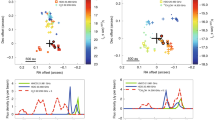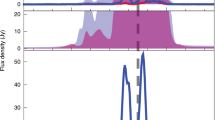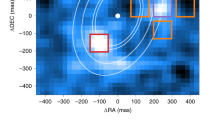Abstract
High-mass protostars (M⋆ > 8M⊙) are thought to gain the majority of their mass via short, intense bursts of growth. This episodic accretion is thought to be facilitated by gravitationally unstable and subsequently inhomogeneous accretion disks. Limitations of observational capabilities, paired with a lack of observed accretion burst events, have withheld affirmative confirmation of the association between disk accretion, instability and the accretion burst phenomenon in high-mass protostars. Following its 2019 accretion burst, a heatwave driven by a burst of radiation propagated outward from the high-mass protostar G358.93-0.03-MM1. Six very long baseline interferometry observations of the radiatively pumped 6.7 GHz methanol maser were conducted during this period, tracing ever increasing disk radii as the heatwave propagated outward. Concatenating the very long baseline interferometry maps provided a sparsely sampled, milliarcsecond view of the spatio-kinematics of the accretion disk covering a physical range of ~50–900 AU. We term this observational approach ‘heatwave mapping’. We report the discovery of a Keplerian accretion disk with a spatially resolved four-arm spiral pattern around G358.93-0.03-MM1. This result positively implicates disk accretion and spiral arm instabilities into the episodic accretion high-mass star formation paradigm.
This is a preview of subscription content, access via your institution
Access options
Access Nature and 54 other Nature Portfolio journals
Get Nature+, our best-value online-access subscription
$29.99 / 30 days
cancel any time
Subscribe to this journal
Receive 12 digital issues and online access to articles
$119.00 per year
only $9.92 per issue
Buy this article
- Purchase on Springer Link
- Instant access to full article PDF
Prices may be subject to local taxes which are calculated during checkout






Similar content being viewed by others
Data availability
Data used in this work can be accessed by searching experiment codes (Table 1) in the following data archives: LBA data (https://atoa.atnf.csiro.au), EVN data (http://archive.jive.nl/scripts/portal.php) and VLBA data (https://data.nrao.edu/portal/#/). The maser spotmaps used in this work, in addition to calibrated data from the six epochs in FITS format, are available at the following link: https://www.masermonitoring.com/g358-mm1-data-availability.
Code availability
The correlate2d algorithm is available from Python’s SciPy package (version 1.10.0). The MCMC algorithm is available from Python’s emcee package (version 3.1.3). The RANSAC algorithm is available from the Python’s scikit-learn package (version 0.19.2).
Change history
16 March 2023
A Correction to this paper has been published: https://doi.org/10.1038/s41550-023-01944-8
References
Caratti o Garatti, A. et al. Disk-mediated accretion burst in a high-mass young stellar object. Nat. Phys. 13, 276–279 (2017).
Hunter, T. R. et al. An extraordinary outburst in the massive protostellar system NGC6334I-MM1: quadrupling of the millimeter continuum. Astrophys. J. Lett. 837, L29 (2017).
Stecklum, B. et al. Infrared observations of the flaring maser source G358.93-0.03. SOFIA confirms an accretion burst from a massive young stellar object. Astron. Astrophys. 646, A161 (2021).
Szymczak, M., Olech, M., Wolak, P., Gérard, E. & Bartkiewicz, A. Giant burst of methanol maser in S255IR-NIRS3. Astron. Astrophys. 617, A80 (2018).
MacLeod, G. C. et al. A masing event in NGC 6334I: contemporaneous flaring of hydroxyl, methanol, and water masers. Mon. Notices Royal Astron. Soc. 478, 1077–1092 (2018).
Volvach, A. E. et al. Monitoring a methanol maser flare associated with the massive star-forming region G358.93-0.03. Mon. Notices Royal Astron. Soc. 494, L59–L63 (2020).
MacLeod, G. C. et al. Detection of new methanol maser transitions associated with G358.93-0.03. Mon. Notices Royal Astron. Soc. 489, 3981–3989 (2019).
Hartmann, L. & Kenyon, S. J. The FU Orionis phenomenon. Annu. Rev. Astron. Astrophys. 34, 207–240 (1996).
Vorobyov, E. I. & Basu, S. The origin of episodic accretion bursts in the early stages of star formation. Astrophys. J. Lett. 633, L137–L140 (2005).
Meyer, D. M.-A., Vorobyov, E. I., Kuiper, R. & Kley, W. On the existence of accretion-driven bursts in massive star formation. Mon. Notices Royal Astron. Soc. 464, L90–L94 (2017).
Meyer, D. M. A. et al. Parameter study for the burst mode of accretion in massive star formation. Mon. Notices Royal Astron. Soc. 500, 4448–4468 (2021).
Jankovic, M. R. et al. Observing substructure in circumstellar discs around massive young stellar objects. Mon. Notices Royal Astron. Soc. 482, 4673–4686 (2019).
Fujisawa, K. et al. A flare of methanol maser in S255. Astron. Telegr. 8286, 1 (2015).
Brogan, C. L., Hunter, T. R., MacLeod, G., Chibueze, J. O. & Cyganowski, C. J. In Astrophysical Masers: Unlocking the Mysteries of the Universe Vol. 336 (eds Tarchi, A. et al.) 255–258 (Cambridge Univ. Press, 2018).
Moscadelli, L. et al. Extended CH3OH maser flare excited by a bursting massive YSO. Astron. Astrophys. 600, L8 (2017).
Szymczak, M., Olech, M., Sarniak, R., Wolak, P. & Bartkiewicz, A. Monitoring observations of 6.7 GHz methanol masers. Mon. Notices Royal Astron. Soc. 474, 219–253 (2018).
MacLeod, G. C. et al. A masing event in NGC 6334I: contemporaneous flaring of hydroxyl, methanol, and water masers. Mon. Notices Royal Astron. Soc. 478, 1077–1092 (2018).
Ginsburg, A., Bally, J., Goddi, C., Plambeck, R. & Wright, M. A Keplerian disk around Orion SrCI, a ~ 15 M⊙ YSO. Astrophys. J. 860, 119 (2018).
Caswell, J. L. et al. The 6-GHz methanol multibeam maser catalogue—I. Galactic Centre region, longitudes 345° to 6°. Mon. Notices Royal Astron. Soc. 404, 1029–1060 (2010).
Chambers, E. T., Yusef-Zadeh, F. & Ott, J. Star formation sites toward the Galactic Center region. The correlation of CH3OH masers, H2O masers, and near-IR green sources. Astron. Astrophys. 563, A68 (2014).
Rickert, M., Yusef-Zadeh, F. & Ott, J. A 6.7 GHz methanol maser survey of the central molecular zone. Mon. Notices Royal Astron. Soc. 482, 5349–5361 (2019).
Hu, B. et al. On the relationship of UC HII regions and Class II methanol masers. I. Source catalogs. Astrophys. J. 833, 18 (2016).
Yonekura, Y. et al. The Hitachi and Takahagi 32 m radio telescopes: upgrade of the antennas from satellite communication to radio astronomy. Publ. Astron. Soc. Jpn 68, 74 (2016).
Cragg, D. M., Sobolev, A. M. & Godfrey, P. D. Models of class II methanol masers based on improved molecular data. Mon. Notices Royal Astron. Soc. 360, 533–545 (2005).
Breen, S. L., Ellingsen, S. P., Caswell, J. L. & Lewis, B. E. 12.2-GHz methanol masers towards 1.2-mm dust clumps: quantifying high-mass star formation evolutionary schemes. Mon. Notices Royal Astron. Soc. 401, 2219–2244 (2010).
Sugiyama, K., Saito, Y., Yonekura, Y. & Momose, M. Bursting activity of the 6.668-GHz CH3OH maser detected in G 358.93-00.03 using the Hitachi 32-m. Astron. Telegr. 12446 (2019).
Brogan, C. L. et al. Sub-arcsecond (sub)millimeter imaging of the massive protocluster G358.93–0.03: discovery of 14 new methanol maser lines associated with a hot core. Astrophys. J. Lett. 881, L39 (2019).
Breen, S. L. et al. Discovery of six new class ii methanol maser transitions, including the unambiguous detection of three torsionally excited lines toward G 358.931-0.030. Astrophys. J. 876, L25 (2019).
Chen, X. et al. 13CH3OH masers associated with a transient phenomenon in a high-mass young stellar object. Astrophys. J. Lett. 890, L22 (2020).
Chen, X. et al. New maser species tracing spiral-arm accretion flows in a high-mass young stellar object. Nat. Astron. 4, 1170–1176 (2020).
Bayandina, O. S. et al. A multitransition methanol maser study of the accretion burst source G358.93-0.03-MM1. Astron. J. 163, 83 (2022).
Burns, R. A. et al. A heatwave of accretion energy traced by masers in the G358-MM1 high-mass protostar. Nat. Astron. 4, 506–510 (2020).
Garay, G., Mardones, D., Rodríguez, L. F., Caselli, P. & Bourke, T. L. Methanol and silicon monoxide observations toward bipolar outflows associated with class 0 objects. Astrophys. J. 567, 980–998 (2002).
Krumholz, M. R., Klein, R. I. & McKee, C. F. Molecular line emission from massive protostellar disks: predictions for ALMA and EVLA. Astrophys. J. 665, 478–491 (2007).
Johnston, K. G. et al. Spiral arms and instability within the AFGL 4176 mm1 disc. Astron. Astrophys. 634, L11 (2020).
Bik, A. & Thi, W. F. Evidence for an inner molecular disk around massive young stellar objects. Astron. Astrophys. 427, L13–L16 (2004).
Kraus, S. et al. A hot compact dust disk around a massive young stellar object. Nature 466, 339–342 (2010).
Wheelwright, H. E. et al. Probing discs around massive young stellar objects with CO first overtone emission. Mon. Notices Royal Astron. Soc. 408, 1840–1850 (2010).
Boley, P. A. et al. The VLTI/MIDI survey of massive young stellar objects. Sounding the inner regions around intermediate- and high-mass young stars using mid-infrared interferometry. Astron. Astrophys. 558, A24 (2013).
Ilee, J. D. et al. CO bandhead emission of massive young stellar objects: determining disc properties. Mon. Notices Royal Astron. Soc. 429, 2960–2973 (2013).
Ramírez-Tannus, M. C. et al. Massive pre-main-sequence stars in M17. Astron. Astrophys. 604, A78 (2017).
Beltrán, M. T. & de Wit, W. J. Accretion disks in luminous young stellar objects. Astron. Astrophys. Rev. 24, 6 (2016).
Ohashi, N. et al. Formation of a Keplerian disk in the infalling envelope around L1527 IRS: transformation from infalling motions to Kepler motions. Astrophys. J. 796, 131 (2014).
Aso, Y. et al. ALMA observations of the transition from infall motion to Keplerian rotation around the late-phase protostar TMC-1A. Astrophys. J. 812, 27 (2015).
Reid, M. J. et al. Trigonometric parallaxes of high-mass star-forming regions: the structure and kinematics of the Milky Way. Astrophys. J. 783, 130 (2014).
Pfalzner, S. Spiral arms in accretion disk encounters. Astrophys. J. 592, 986–1001 (2003).
Cuello, N. et al. Flybys in protoplanetary discs. I. Gas and dust dynamics. Mon. Notices Royal Astron. Soc. 483, 4114–4139 (2019).
Cuello, N. et al. Flybys in protoplanetary discs. II. Observational signatures. Mon. Notices Royal Astron. Soc. 491, 504–514 (2020).
Forgan, D. H., Ilee, J. D. & Meru, F. Are Elias 2-27’s spiral arms driven by self-gravity, or by a companion? A comparative spiral morphology study. Astrophys. J. Lett. 860, L5 (2018).
Dipierro, G., Pinilla, P., Lodato, G. & Testi, L. Dust trapping by spiral arms in gravitationally unstable protostellar discs. Mon. Notices Royal Astron. Soc. 451, 974–986 (2015).
Ahmadi, A., Kuiper, R. & Beuther, H. Disc kinematics and stability in high-mass star formation. Linking simulations and observations. Astron. Astrophys. 632, A50 (2019).
Bae, J., Hartmann, L., Zhu, Z. & Nelson, R. P. Accretion outbursts in self-gravitating protoplanetary disks. Astrophys. J. 795, 61 (2014).
Motogi, K. et al. A face-on accretion system in high-mass star formation: possible dusty infall streams within 100 AU. Astrophys. J. 849, 23 (2017).
Toomre, A. On the gravitational stability of a disk of stars. Astrophys. J. 139, 1217–1238 (1964).
Kratter, K. & Lodato, G. Gravitational instabilities in circumstellar disks. Annu. Rev. Astron. Astrophys. 54, 271–311 (2016).
Lodato, G. & Rice, W. K. M. Testing the locality of transport in self-gravitating accretion discs. Mon. Notices Royal Astron. Soc. 351, 630–642 (2004).
Lau, Y. Y. & Bertin, G. Discrete spiral modes, spiral waves, and the local dispersion relationship. Astrophys. J. 226, 508–520 (1978).
Harsono, D., Alexander, R. D. & Levin, Y. Global gravitational instabilities in discs with infall. Mon. Notices Royal Astron. Soc. 413, 423–433 (2011).
Lodato, G. & Rice, W. K. M. Testing the locality of transport in self-gravitating accretion discs. II. The massive disc case. Mon. Notices Royal Astron. Soc. 358, 1489–1500 (2005).
Kratter, K. M., Matzner, C. D., Krumholz, M. R. & Klein, R. I. On the role of disks in the formation of stellar systems: a numerical parameter study of rapid accretion. Astrophys. J. 708, 1585–1597 (2010).
Klassen, M., Pudritz, R. E., Kuiper, R., Peters, T. & Banerjee, R. Simulating the formation of massive protostars. I. Radiative feedback and accretion disks. Astrophys. J. 823, 28 (2016).
Beuther, H. et al. Fragmentation and disk formation in high-mass star formation: the ALMA view of G351.77-0.54 at 0.06” resolution. Astron. Astrophys. 603, A10 (2017).
Sanna, A. et al. Discovery of a sub-Keplerian disk with jet around a 20 M⊙ young star. ALMA observations of G023.01-00.41. Astron. Astrophys. 623, A77 (2019).
Motogi, K. et al. The first bird’s-eye view of a gravitationally unstable accretion disk in high-mass star formation. Astrophys. J. Lett. 877, L25 (2019).
Frank, J., King, A. & Raine, D. J. Accretion Power in Astrophysics 3rd edn (Cambridge Univ. Press, 2002).
Shakura, N. I. & Sunyaev, R. A. Black holes in binary systems. Observational appearance. Astron. Astrophys. 24, 337–355 (1973).
Meyer, D. M. A., Kuiper, R., Kley, W., Johnston, K. G. & Vorobyov, E. Forming spectroscopic massive protobinaries by disc fragmentation. Mon. Notices Royal Astron. Soc. 473, 3615–3637 (2018).
Cossins, P., Lodato, G. & Clarke, C. J. Characterizing the gravitational instability in cooling accretion discs. Mon. Notices Royal Astron. Soc. 393, 1157–1173 (2009).
Hirota, T. et al. Disk-driven rotating bipolar outflow in Orion Source I. Nat. Astron. 1, 0146 (2017).
Burns, R. A. et al. A ‘water spout’ maser jet in S235AB-MIR. Mon. Notices Royal Astron. Soc. 453, 3163–3173 (2015).
Cesaroni, R. et al. Radio outburst from a massive (proto)star. When accretion turns into ejection. Astron. Astrophys. 612, A103 (2018).
Moscadelli, L. et al. Protostellar outflows at the earliest stages (POETS). III. H2O masers tracing disk-winds and jets near luminous YSOs. Astron. Astrophys. 631, A74 (2019).
Bayandina, O. S. et al. The evolution of the H2O maser emission in the accretion burst source G358.93-0.03. Astron. Astrophys. 664, A44 (2022).
Asaki, Y. et al. Verification of the effectiveness of VSOP-2 phase referencing with a newly developed simulation tool, ARIS. Publ. Astron. Soc. Jpn 59, 397–418 (2007).
Lee, C.-F., Li, Z.-Y. & Turner, N. J. Spiral structures in an embedded protostellar disk driven by envelope accretion. Nat. Astron. 4, 142–146 (2020).
Acknowledgements
R.A.B. acknowledges support through the EACOA Fellowship from the East Asian Core Observatories Association. R.A.B., J.O.C. and G.C.M. acknowledge the Global Emerging Radio Astronomy Foundation for contributions to radio astronomy. T.H. is financially supported by the MEXT/JSPS KAKENHI Grant nos. 17K05398, 18H05222 and 20H05845. Y.Y. is financially supported by the MEXT/JSPS KAKANHI Grant nos. 21H01120 and 21H00032. L.U. acknowledges support from the University of Guanajuato (Mexico) Grant ID CIIC 164/2022. A.C.o.G. acknowledges support by PRIN-INAF-MAIN-STREAM 2017. M.O. thanks the Ministry of Education and Science of the Republic of Poland for support and granting funds for the Polish contribution to the International LOFAR Telescope (arrangement no. 2021/WK/02) and for maintenance of the LOFAR PL-612 Baldy (MSHE decision no. 28/530020/SPUB/SP/2022). A.B. and M.D. acknowledge support from the National Science Centre, Poland through Grant 2021/43/B/ST9/02008. O.B. acknowledges financial support from the Italian Ministry of University and Research – Project Proposal CIR01_00010. A.M.S. and D.A.L. were supported by the Ministry of Science and Higher Education of the Russian Federation (state contract FEUZ-2023-0019). D.J. is supported by NRC Canada and by an NSERC Discovery Grant.
Author information
Authors and Affiliations
Contributions
R.A.B. led the project as principal investigator for the observations, processed the VLBI data and authored the paper. Y.U. performed the Keplerian modelling of the maser data. N.S. performed the spiral arm identification procedures using RANSAC and MCMC. J. Blanchard conducted the two-dimensional cross-correlation for identification of additional spiral arms. Z.R. conducted the disk inclination measurement. K.S. and Y.Y. selected the target maser source. A.E.V., J. Brand, S.P.v.d.H., Y.Y., Y.T., A.A., G.C.M., M.O. and M.D. conducted single-dish monitoring of masers towards G358.93-0.03. G.O., S.P.E., L.H. and C.P. conducted the LBA observations. All authors contributed to the scientific discussion and helped with the authorship and reviewing process of the paper.
Corresponding author
Ethics declarations
Competing interests
The authors declare no competing interests.
Peer review
Peer review information
Nature Astronomy thanks the anonymous reviewers for their contribution to the peer review of this work.
Additional information
Publisher’s note Springer Nature remains neutral with regard to jurisdictional claims in published maps and institutional affiliations.
Rights and permissions
Springer Nature or its licensor (e.g. a society or other partner) holds exclusive rights to this article under a publishing agreement with the author(s) or other rightsholder(s); author self-archiving of the accepted manuscript version of this article is solely governed by the terms of such publishing agreement and applicable law.
About this article
Cite this article
Burns, R.A., Uno, Y., Sakai, N. et al. A Keplerian disk with a four-arm spiral birthing an episodically accreting high-mass protostar. Nat Astron 7, 557–568 (2023). https://doi.org/10.1038/s41550-023-01899-w
Received:
Accepted:
Published:
Issue Date:
DOI: https://doi.org/10.1038/s41550-023-01899-w



